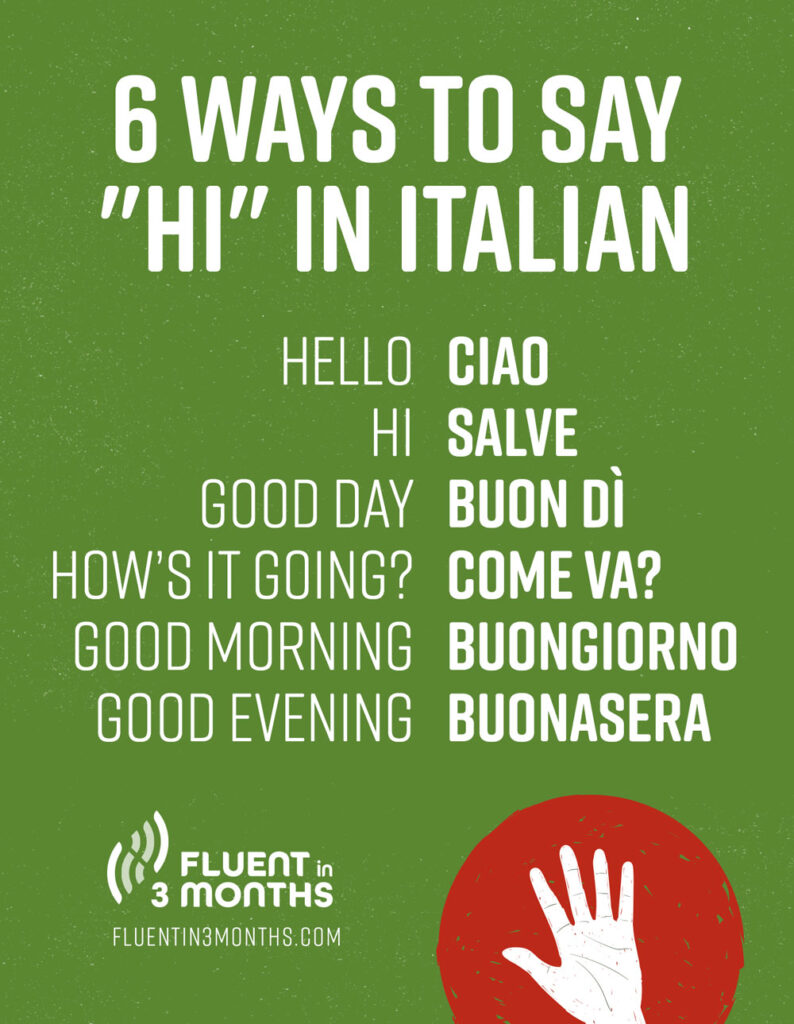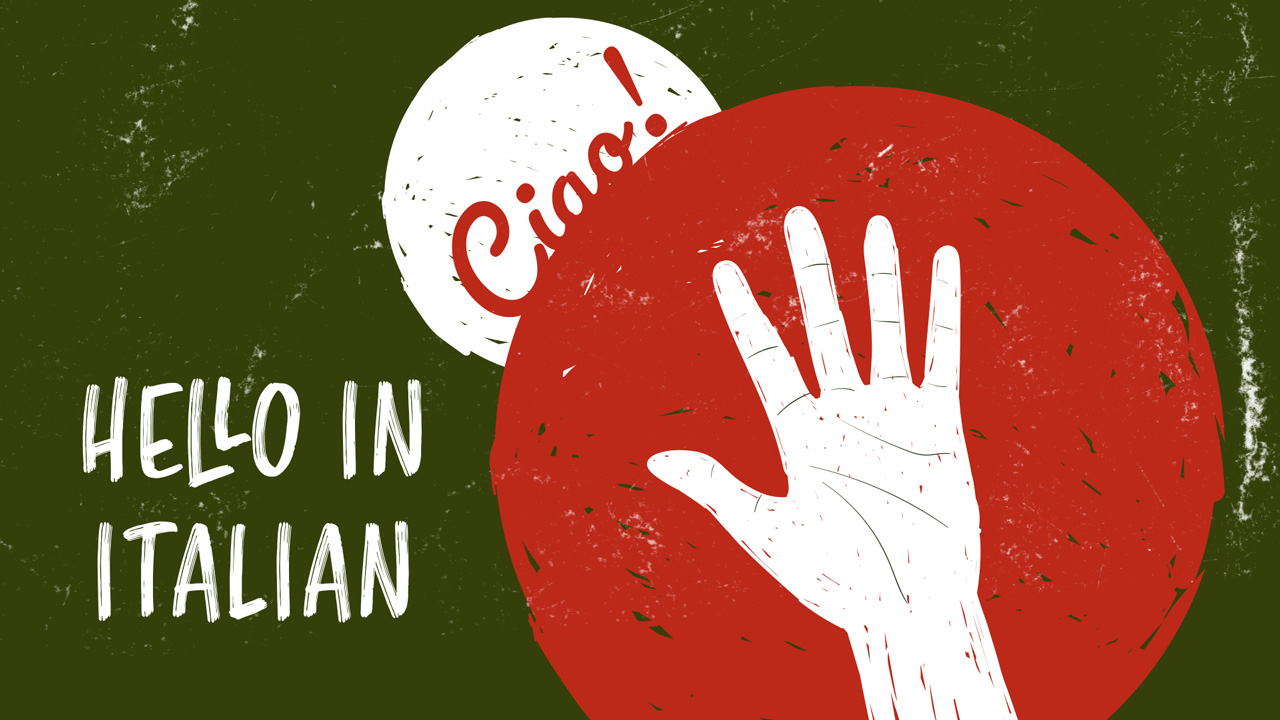How to Say “Hello” in Italian: 19 Italian Greetings
We all know that Italians love chiacchierare (“to chat”) so much that it’s no surprise there are a lot of different Italian greetings. There are plenty of different ways to say “hello” in Italian. The greeting you use will depend on the context and the time of day.
Whether it’s a formal context all’Ufficio Postale (“the Post-Office”), or informal at la pizzeria, you’ll never get bored using the same greeting!
Each Italian region has a sub-compilation of greetings in its own local dialect, however, these are the most popular in standard Italian that you’ll come across and that you’ll be able to use from Monte Bianco in the Alps to Monte Etna in Sicily.
Table of contents
- 1. “Hello” in Italian – Ciao
- 2. “Good morning” in Italian – Buongiorno
- 3. “Have a Good Day” in Italian – Buona Giornata
- 4. “Good Day” in Italian – Buon Dì
- 5. “Good Afternoon” in Italian – Buon Pomeriggio
- 6. “Hi” in Italian – Salve
- 7. “Hey” in Italian – Ehilà, Ueilà or Ehi
- 8. “How’s it Going?” in Italian – Come va?
- 9. “Good Evening” in Italian – Buona Sera
- 10. “Have a Good Evening” in Italian – Buona Serata
- 11. “Good Night” in Italian – Buonanotte
- 12. “See You Soon” in Italian – A Presto
- 13. “Until next time” in Italian – Alla Prossima
- 14. “See You Around” in Italian – Ci Vediamo
- 15. “Bye” in Italian – Ti Saluto / Vi Saluto
- 16. “Take Care” in Italian – Stammi Bene / Statemi Bene
- 17. “Goodbye” in Italian – Arrivederci
- 18. “Farewell” in Italian – Addio
- 19. “Bye Guys” in Italian – Bona Raga
- What’s Your Favourite Italian Greeting?

1. “Hello” in Italian – Ciao
One of the most popular Italian words, ciao has been adopted as a friendly salutation all around the globe. It’s an informal greeting to say “hello” or “goodbye” and it originates from the Venetian sciavo, which comes from the Latin word schiavo – literally “your humble servant”.
The modern Italian language has lost all its servile connotations. So you can say ciao when meeting someone or when leaving, and when you come across a friend: Ciao, bello!
2. “Good morning” in Italian – Buongiorno
Buongiorno is equivalent to ”good morning” in English, but it’s also commonly used throughout the day to say ”good day” as a formal alternative to ciao.
You can use it when introducing yourself or simply as a polite greeting when entering public places.
Here’s an example:
Buongiorno, vorrei un caffe. – “Hello, I would like a coffee.”
And here’s a popular question about this greeting: how do you reply to buongiorno? You can say buongiorno a te in an informal situation or buongiorno a Lei in a formal situation.
These replies can be translated as “good day to you”, but sound way less formal in Italian.
3. “Have a Good Day” in Italian – Buona Giornata
You can create a subtle change in meaning in buongiorno when you replace giorno with giornata, and it becomes buona giornata. This is used to wish someone a ”good day” formally or informally when you’re saying goodbye.
Ci vediamo stasera, buona giornata! – “I’ll see you this evening, have a good day!”
4. “Good Day” in Italian – Buon Dì
Buon dì is yet another variation of buongiorno, although it’s not as common, it’s used in the same way. If you’re looking to impress someone with a fancier greeting, this one will do the job. Just like buongiorno it can be used formally and informally.
Dì comes from the Latin word dies meaning “day”.
Here’s an example:
Buon dì, come va? – “Good morning, how’s it going?”
5. “Good Afternoon” in Italian – Buon Pomeriggio
When the afternoon comes around, we can switch our salutation to buon pomeriggio if we’re feeling adventurous. Or we can just continue using buongiorno, which I believe is usually preferred because it has fewer syllables and therefore requires less effort!
So if you enter, let’s say, una pasticceria (a “patisserie”) at 2 p.m. you can either say buon pomeriggio or buongiorno.
Here’s an example of how to use it:
Buon pomeriggio, due cannoli, per favore! – “Good afternoon, two cannoli, please!”
6. “Hi” in Italian – Salve
If you’re a little tired of saying ciao or buongiorno throughout the day, here’s a friendly and polite version that also has the advantage of being both formal and informal.
Salve comes from the Latin verb salvere, to be well, in good health (essere in buona salute). In fact, the verb salutare comes from the Italian word salute (“health”), hence the English word salutation.
So if you want to greet a stranger in piazza (“in the square”), you can say Salve, come va? (“Hello, how’s it going?”).
7. “Hey” in Italian – Ehilà, Ueilà or Ehi
Italians usually use these words to greet friends and family expressing a positive surprise.
For example, Ehilà, chi si rivede! (“Hey, look who’s here!”).
But they also can serve as a warning: Ehi, chi è entrato in casa mia? (“Hey, who entered my home?”).
8. “How’s it Going?” in Italian – Come va?
When you run into a friend, you can say come va?, but be prepared. In Italian it often entails a detailed answer and perhaps several long minutes of storytelling with an espresso coffee at the bar.
If you don’t have time to chat, just stick to ciao!
9. “Good Evening” in Italian – Buona Sera
When the evening comes around you say buona sera (”good evening”). You can use this greeting as early as 5 p.m. and as late as 10 p.m. in formal and informal settings, but only when you’re arriving, not when leaving.
10. “Have a Good Evening” in Italian – Buona Serata
When departing in the evening, you’d say buona serata (’'have yourself a good evening”). It works like buona giornata, therefore, it’s not a conversation starter. Here’s an example:
Ci vediamo domani, buona serata! – “See you tomorrow, have a good evening!”
11. “Good Night” in Italian – Buonanotte
If you’re on your way home or to bed, you say buonanotte (”goodnight”).
Unlike buonasera, it’s not a conversation starter, but is used when bidding someone a good night, as in this example:
È tardi vado a casa, buonanotte. – “It’s late, I’m going home, goodnight.”
12. “See You Soon” in Italian – A Presto
This Italian greeting simply means “see you soon” and it’s fairly common when departing from someone. You’ll also find it as an informal greeting at the end of emails. However, just like in English, it could mean that you’re actually about to see someone soon. For example: Arrivo da te tra poco, a presto! (“I’ll be at your place in a bit, see you soon!”).
13. “Until next time” in Italian – Alla Prossima
This salutation works fine whether you have plans to meet again, whether soon or not.
For example, you can say it to your teacher and classmates after an Italian lesson…alla prossima.
14. “See You Around” in Italian – Ci Vediamo
Here’s a more casual version of arrivederci which you’ll find further ahead in this list. It’s translated into English as “we’ll see each other around” or just ”see you around”. You’ll hear it said often among friends when they’re parting ways.
Here’s an example:
Antonio, ora scappo. Ci vediamo. – “Antonio, I must run off now. See you around.”
15. “Bye” in Italian – Ti Saluto / Vi Saluto
This casual departure salutation means ”I salute you” or simply “bye”. If you’re saying it to one person you use the singular form ti saluto. If to more than one person, then you’ll use the plural form vi saluto. Here’s an example with the plural form:
Amici, vi saluto. – “Friends, I salute you.”
16. “Take Care” in Italian – Stammi Bene / Statemi Bene
The Italian version of ”take care” has a singular and a plural version, just like the previous salutation. So you’ll say stammi bene to one person or statemi bene to more than one person.
Nonna, stammi bene. – “Grandma, take care.”
17. “Goodbye” in Italian – Arrivederci
One of the hardest to pronounce in this list, but good practice for the rolling “r”. Arrivederci is translated as ”good-bye”, but it literally means ”till we see each other again”. In fact, if you break it down into its components you’ll get: a – preposition, rivedere – verb, ci – reflexive pronoun.
You can use it as a polite salutation when departing. For example: Arrivederci, professoressa. (“Good-bye, professor.“).
18. “Farewell” in Italian – Addio
This one creates quite a dramatic effect in films, such as the Italian film of the 50s Addio, Napoli! (“Farewell, Naples!”).
It’s the contracted form of a Dio piacendo, a friendly wish that the goodwill of God be made for the person to whom it’s addressed.
Nowadays, it’s used as a final salutation if you don’t plan to see someone ever again. In most cases, a simple arrivederci will do!
19. “Bye Guys” in Italian – Bona Raga
I lived in Florence for many years of my life, so of course, I couldn’t resist ending this list by sharing a Florentine farewell.
Bona raga is fiorentino, Florentine slang for “bye, guys” (ciao, ragazzi). It’s used when departing from your friends.
Here’s an example:
Bona raga, vo’ a casa. – “Bye guys, I’m going home.”
PS: If you want to hear about the experience of an Italian learner living in Italy, check out this episode of the Language Hacking Podcast:
What’s Your Favourite Italian Greeting?
So there you go, now you’ve got lots of Italian greetings, and ways of saying “hello” and “goodbye” in Italian. If you’re feeling creative you can use a combination of them.
You can practice using these greetings with your Preply tutor so they become more natural to you in conversations. It’s all about learning the right way to use them from a native speaker!
Anyway, Stammi bene e alla prossima! (“Take care, until next time!”).
Original article by Mirella Colalillo, updated by the Fluent in 3 Months team.



Social